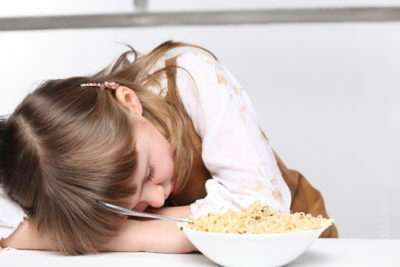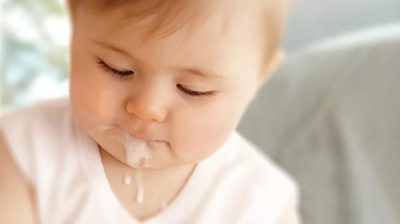1 Etiology of the phenomenon
Among the causes of this symptom are both diseases and banal overeating. Most often, children feel nauseated after eating.

Recommended to read
- Treatment of enterovirus infection in children
- Nutrition of the child for poisoning
- What drugs can help a child with nausea and vomiting
- Effective remedy for gastritis and stomach ulcer
2 Nausea after ingestion
- Regurgitation due to ingestion during eating large amounts of air. This is quite normal and acceptable phenomenon, but only if the regurgitation occurs not more often 2-3 times a day and in small volumes. If the child belches frequently and a lot, then this can be a sign of a serious illness of the gastrointestinal tract. Then it is worth immediately contacting the pediatrician and gastroenterologist.
- Overeating and overfeeding a child( especially greasy food).In this case, vomiting usually occurs once, after which the child is relieved. A child is better to feed in small quantities, but more often. Oily and heavy food from the diet should be excluded.
Do you have gastritis?
GALINA SAVINA: "How easy is it to cure gastritis at home for 1 month. A proven method - write down a recipe. ..!"Read more & gt; & gt;

3 Outcome of poisoning or infection
- Food poisoning due to ingestion of poor-quality or out-of-date food. As a rule, in this case, you can join diarrhea and abdominal pain. It is necessary to help the child as soon as possible to clean the stomach of poor-quality and not yet completely digested food. To do this, give him to drink 1-2 cups with slightly salted water or with a weak solution of potassium permanganate, and then cause vomiting, lightly pressing a teaspoon on the root of the tongue. In parallel, it is necessary to call the pediatrician.
- Intestinal infections. Clinical manifestations in this case are similar to food poisoning, but in the vomit masses may appear abundant bile impurities, and of the general symptoms, weakness, headaches due to intoxication and increased body temperature. In such a situation, you should immediately call an ambulance and do not try to give your child any medication yourself.
- Enterovirus infections. Most often, vomiting after eating occurs when the child is infected with rotavirus infection. This infection is very contagious( contagious).The path of its transmission can be both fecal-oral( unwashed hands), and air-drop.
- With this pathology, vomiting after eating is sudden and profuse, the so-called vomiting fountain. Of the accompanying symptoms are characterized by dyspepsia( belching, aching pain in the epigastrium, increased intestinal peristalsis), diarrhea, general weakness, high fever. Treatment of this viral pathology is usually symptomatic. The child in this period is better not to feed, but to give a few tablespoons of the Smecta drug or to fill the loss of fluid and electrolytes, give the solution of Regidron a small sip with an interval of 10 minutes. And as soon as possible, call the doctor at home.
-
 IMPORTANT TO KNOW! Gastritis? Ulcer? To have a stomach ulcer not turned into cancer, drink a glass. ..Read the article & gt; & gt;
IMPORTANT TO KNOW! Gastritis? Ulcer? To have a stomach ulcer not turned into cancer, drink a glass. ..Read the article & gt; & gt;
4 Other Common Causes of
- Poisoning by Chemicals( Household Chemicals, Paintwork and Cosmetics).Well, if the parents on time noticed that their curious kid took in the mouth of any of these funds. In this case, it is possible to take quick and adequate measures to eliminate undesirable consequences for the child's organism. The child should be given plenty of clean boiled water and try to induce vomiting. Also it is worth immediately contacting a doctor: exposure to children's body of these chemicals can cause severe systemic diseases and even irreversible consequences for the child.
- Allergic reactions to certain foods and medications. The child immediately after eating a product or medicine has an attack of severe nausea, resulting in vomiting. In this case, you should try to rinse the stomach in the manner described above and call a doctor who will prescribe adequate therapy( most likely desensitizing).
- Vomiting as a result of increased blood pressure. If the child has not eaten for a long time, then vomiting in this situation may not occur( only nausea).If he just ate plenty, then immediately vomiting will follow. If this situation is repeated repeatedly, then you need to see a doctor to identify your hypertension and the appropriate treatment. It is impossible to treat the child independently in this case.
- Stress and nervous overexertion. Often, nausea and vomiting in a child can occur immediately after eating, if it is in a nervous and overexcited state. Usually, a vomiting attack in this case happens once. Parents should, if possible, put the child in bed, do not feed him in the next hour, try to calm him down( calmly talk, read an interesting book) and let them take any easy soothing means. If such situations repeat, and the child constantly reacts to nervous tension with vomiting, then it is necessary to consult a doctor.
- Disturbance of the vestibular apparatus in seasickness. Most often, vomiting in this case will occur after eating, although it can occur without prior food intake. To this end, if possible, put the child on a firm and fixed surface. Then you should contact the pediatrician for the purpose of prescribing any medications or appropriate exercises for training the vestibular apparatus.
- Vomiting in a child after eating can also occur with a change of climate or a familiar kitchen. Especially often this happens in trips to resorts in an unusual climatic zone. Usually acclimatization in children passes quickly enough, but if vomiting after eating in another's climate repeats, it is necessary to address to the local pediatrician.
-
 Gastroenterologist. IMPORTANT: "I beg, if you began to worry about abdominal pain, heartburn, nausea, do not in any way do gases. .."Read more & gt; & gt;
Gastroenterologist. IMPORTANT: "I beg, if you began to worry about abdominal pain, heartburn, nausea, do not in any way do gases. .."Read more & gt; & gt;
If parents know the causes of nausea and vomiting in a child after eating and what actions need to be taken while doing this, they will always cope with the situation themselves.
- 1 Etiology of the phenomenon
- 2 Nausea after ingestion
- 3 Outcome of poisoning or infection
- 4 Other common causes
Vomiting in a child after eating is an involuntary, reflex reduction of the walls of the stomach and the release of its contents outside. After this, there is complete or partial relief, nausea recedes.



